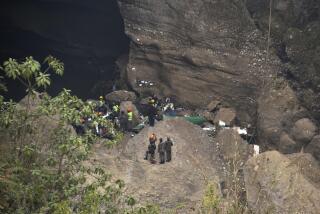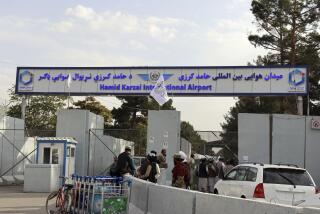Germanwings cockpit recording to be analyzed for alarms, voices before crash
Reporting from Paris — French air accident investigators said Wednesday that they had extracted an audio file from the cockpit voice recorder of the Germanwings Airbus that crashed in the Alps with 150 people aboard.
U.S. officials confirmed that three Americans were among the dead, one of whom worked for a government intelligence agency.
Remi Jouty, spokesman for the BEA, the French air accident investigations bureau, refused to give full details about the voice recorder and said experts still had no idea why the plane appeared to have flown straight into a mountain. He said the bureau’s job was to analyze and “understand the sounds, alarms and voices and attribute those voices to different people.”
However, the New York Times, citing a senior military official taking part in the investigation, said evidence from the voice recorder suggested that one pilot had left the cabin and was unable to get back in as the plane went into its fatal descent.
“You can hear he is trying to smash the door down,” the investigator told the newspaper, speaking on condition of anonymity. It is not clear what might have happened to the pilot who remained in the locked cabin.
Airlines have beefed up their cockpit doors since the Sept. 11, 2001, hijackings, making them bulletproof and requiring that they be locked in flight.
Jouty, speaking to journalists at Le Bourget airport outside Paris, had said the recording was extracted with “some difficulty” and suggested that there was no “midair explosion” and no sign that the Airbus A320 jet had suffered a “classic depressurization situation.”
He said he was “reasonably optimistic” that the flight data recorder would be found and that authorities could establish what caused Germanwings Flight 9525 to crash Tuesday on its flight from Barcelona, Spain, to Duesseldorf, Germany.
“We have an audio file we can use. The crash zone is [about 5 acres], which is big but not massive. We are combing the site and we will find the flight data recorder, which is built to resist a severe crash. I am confident we will find out what happened.”
Jouty said it was too soon to give details of the cockpit recording or explain why the crew failed to respond to air traffic control radio calls and sent out no distress signal as the aircraft descended rapidly, but not uncontrollably, before slamming into a mountain shortly before 11 a.m. at an estimated 435 mph. There was radio silence from the plane for at least eight minutes as it dropped.
“We’re not in the position to offer the slightest explanation or interpretation of what could have caused this plane to descend, or the reasons for which it would have continued to descend, unfortunately, right to the ground, or the reasons why it appears not to have replied to the attempts by air traffic control to contact it,” Jouty said.
“At this stage we have not ruled out any hypotheses.... It’s too soon to draw any conclusions,” he said.
Jouty said the last recorded message from the plane came at 10:30 a.m., when air traffic control at Aix-en-Provence responded to the crew’s request for permission to continue the plane’s route.
“Shortly afterward, the aircraft started a descent that continued right up to impact just under 10 minutes later,” Jouty said.
“We lost the radar signal from the aircraft extremely close to the site of impact, at which point the aircraft was at 6,000 feet. This means the radar followed the plane to just before impact.”
The State Department identified two of the Americans who died as Yvonne and Emily Selke, a mother and daughter from Nokesville, Va., and said it was in touch with the family of the third American, who was not identified.
“We are continuing to review our records to determine whether any other U.S. citizens might have been on board the flight,” the department said in a statement.
The Selke family handed out a statement to reporters at their home in Nokesville. “Our entire family is deeply saddened by the losses of Yvonne and Emily Selke,” it said. “Two wonderful, caring, amazing people who meant so much to so many. At this difficult time we respectfully ask for privacy and your prayers.”
Yvonne Selke was a contract employee of the National Geospatial-Intelligence Agency, which produces maps and interprets satellite imagery for U.S. intelligence operatives and special operations missions. It is the agency that produced models of Osama bin Laden’s house in Pakistan to help Navy SEALs in the raid that killed the Al Qaeda leader.
“Every death is a tragedy, but seldom does a death affect us all so directly and unexpectedly,” NGA Director Robert Cardillo said in a statement. “All of us offer our deepest condolences and will keep her family and her colleagues in our thoughts.”
Selke worked for the intelligence agency through Booz Allen, the management consulting firm, which said she was a “dedicated employee” who had been with the company for nearly 23 years.
Emily Selke graduated with honors from Drexel University in 2013 as a music industry major, according to a statement from the school.
“Emily always put others before herself and cared deeply for all those in her life,” said a statement posted on Facebook by her sorority, the Zeta chapter of Gamma Sigma Sigma.
A full list of the identities of those aboard the doomed Germanwings flight has not yet been released by Lufthansa, parent company of the low-cost airline, but the dead are reported to have come from 16 countries. The largest number of passengers were from Germany, 72 people, and Spain, 49.
“The establishing of the nationality of some of the passengers is proving difficult. We are in contact with a total of 123 families,” said Thomas Winkelmann, chief executive of Germanwings.
Prime Minister Manuel Valls added that he hoped identification of the victims and the release of their names would be done “as soon as possible,” but that this information had to come from Lufthansa, which would not release it until all victims’ families had been notified.
French Interior Minister Bernard Cazeneuve said that the inquiry would take weeks and that though terrorism was not at the top of the list of possible causes, nothing had been ruled out.
Carsten Spohr, chief executive of Lufthansa, Germanwings’ parent company, said during a news conference in Barcelona that the Airbus involved in the crash had received a “clean maintenance bill” the day before the crash.
French President Francois Hollande, Spanish Prime Minister Mariano Rajoy and German Chancellor Angela Merkel arrived in the crash zone Wednesday. Hollande and Merkel had made a detour to fly over the ravine littered with the wreckage of the Airbus before arriving at the mountain village of Seyne-les-Alpes. Rajoy arrived by road.
They met gendarmes, mountain rescue teams, members of the Red Cross and others involved in the search for bodies and evidence to explain the cause of the crash. French air accident investigators have been joined by their German counterparts at the scene. They were still searching for the flight data recorder Wednesday afternoon.
Afterward, the three leaders met victims’ families who had traveled to villages around the crash zone and expressed their solidarity and condolences.
Six crew members and 144 passengers, who included two babies and 16 German schoolchildren returning from an exchange trip to Spain with their two teachers, died in the crash. Staff members at the Joseph-Koenig Gymnasium school at Haltern am See, not far from Duesseldorf, held a special assembly in their memory and employees at Germanwings’ headquarters in Cologne organized a silent tribute to the dead.
Willsher is a special correspondent. Times staff writers Sarah Parvini in Los Angeles and Brian Bennett in Washington contributed to this report.
More to Read
Sign up for Essential California
The most important California stories and recommendations in your inbox every morning.
You may occasionally receive promotional content from the Los Angeles Times.










